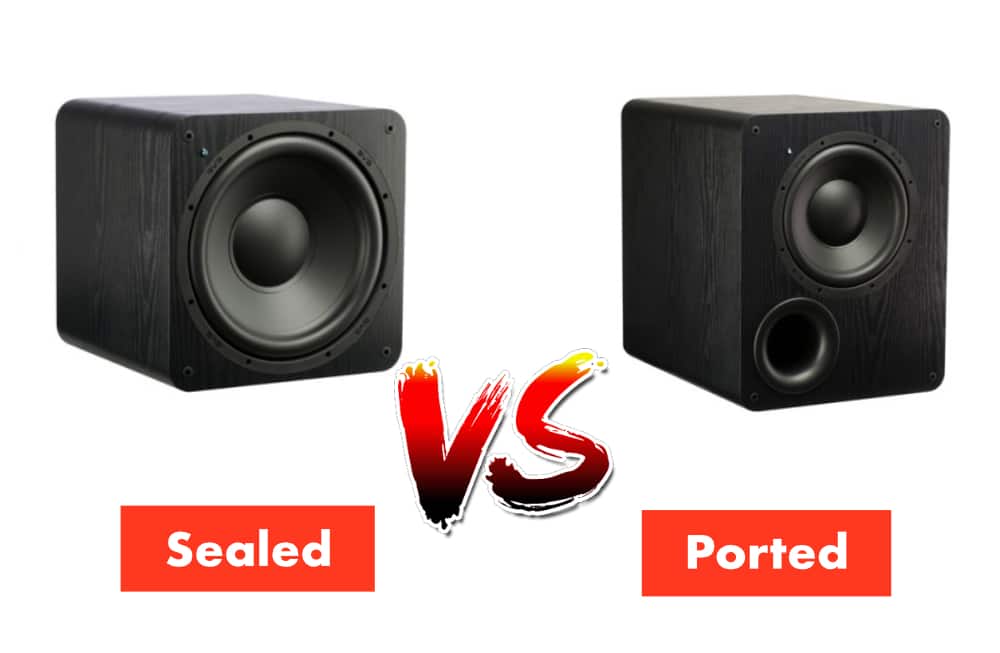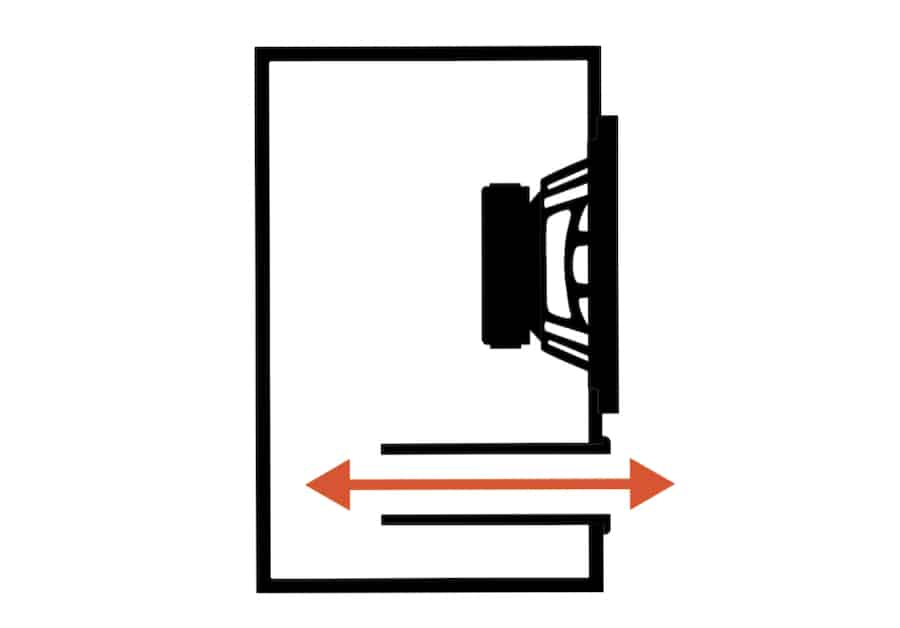Ported vs Sealed Subwoofer: Sub Comparison & Guide For 2023
When it comes to choosing a subwoofer for your home theater or car audio system, you have two distinct options: ported vs sealed subwoofer. Your choice between the two will depend on the type of sound you desire and the size of the room or vehicle.
A ported subwoofer is a type of speaker system that is designed to give you a powerful, deep bass sound. This type of subwoofer utilizes a special “ported” enclosures which is designed with a tuned opening that amplifies and extends the bass response of the speaker.
The ported enclosure creates a unique sound that is louder, deeper, and more dynamic than other subwoofer designs. It is the perfect way to add a powerful punch to your system. With its deep, thunderous bass frequency signals, ported subs have become increasingly popular among music enthusiasts, home theater fans, and even professional DJs who want to add extra impact to their sound.
While large sealed subwoofers consist of very flat frequency response that allows to produce tight, deep bass tones. Sealed subs are a popular choice among audiophiles because of their ability to reproduce low-end frequencies response consumes amplifier power with remarkable accuracy and excellent sound quality.
This is due to the fact that sealed woofers have an airtight sealed enclosure that prevents the sound from leaking out. This also helps to reduce any distortion that may occur, resulting in a pure, clean sound. Additionally, sealed woofers tend to be more efficient than ported subwoofers, meaning they can provide more power with less energy input.
Sealed and ported subwoofers are both powerful choices for bass-lovers looking to take their sound system to the next level. But if you’re looking for a deeper, richer experience, a ported sub is definitely the way to go. However, if you prefer a more restrained, accurate sound, a sealed sub might be the right choice.
Ported Subwoofers versus Sealed Subwoofers: Main Differences
Ported woofers are a popular choice for many audio enthusiasts, offering powerful bass performance. A ported subwoofer uses a vent, or port, in the enclosure to allow the driver to move more air in and out of the cabinet, resulting in a much deeper and more powerful bass than a sealed model.
The design of the port, as well as its size and placement, can have a great effect on the speaker output. Generally speaking, larger port sizes and shorter port lengths will result in more even bass output. In comparison, smaller port sizes and longer port lengths will result in higher frequency response and less booming bass.
Sealed speakers are also popular choice for home theater and car sound systems, offering a powerful and balanced bass sound. The design of sealed enclosures consists of an airtight enclosure and a woofer that is sealed, meaning that no air escapes from the cabinet. This design provides an accurate bass that is well-suited for music and movies.
The frequency range of sealed speakers is generally around 20 Hz to 200 Hz, allowing them to produce a full range of bass sounds. The response curve is usually smooth and flat, allowing for excellent sound reproduction.
However, sealed designs can be slightly less efficient than other designs, such as ported woofers, which can lead to a decrease in low-frequency output despite the accuracy of the sound.
Pros and Cons of Sealed vs. Ported Subwoofer Enclosure

When it comes to subwoofers, the type of subwoofer you choose will depend on what you want out of your audio experience. Ultimately, the type of subwoofer you use will affect your experience in a variety of ways.
Here are some of the pros and cons associated with each type of subwoofer, so you can make the best decision for your needs.
Ported Subwoofers

Ported subs allow you to play a louder bass with the same amplifier power compared to other types of subwoofers. You would be able to boost those low frequencies with less noise, which would improve the room gain.
Using two or more subwoofers is always a better solution to having even better sound quality in a larger room, as the volume and depth of bass can be evenly distributed. Multiple subwoofers can help you boost your sound system’s output while keeping it clear.
Like a sealed speaker, porting increases system output at the vent’s resonant frequency, thereby extending the subwoofer’s response and allowing greater output capability at the turning point. However, you can crank up the sound pressure levels higher with ported boxes while maintaining good system performance.
Ported models are preferred over sealed models for a home audio system because they provide superior dynamic impact and deep bass extension. Overall, ported enclosures are bigger and wider than their sealed counterparts.
Pros:
- More bass in a very large room
- Increased power handling capabilities
- Higher peak dynamic output
- Unobstructed sound reproduction
- Increased bass extension and intelligibility
- Enclosure volume can be optimized for specific applications
Cons:
- Risk of air leakage from the port
- Increased port turbulence
- Potential bass distortion
- Limited tuning options compared to sealed models
- Larger cabinet volume
Sealed Subwoofers

Sealed boxes allow you to play tight and accurate bass notes. Sealed speaker boxes produce a more musical and less three-dimensional sound than larger ported or vented boxes due to reduced phase rotation, less ringing, and a lower group delay.
When a quality subwoofer is placed inside one of these enclosures, the sealed air inside acts as a damper, regulating the cones’ back-and-forth motion smoothly so that all the notes are produced and heard uniformly.
Meaning they can play louder and cleaner with less power as the air inside the box helps absorb some of the vibrations. A bass roll off is used to modify the perceived sound, allowing the listener to experience a fuller, more nuanced range of sound without distortion or muddiness.
Pros:
- They provide tighter, more accurate bass
- Lower distortion levels at higher volumes
- Designed to fit in tight spaces
- Easier to control than non-sealed box
- Subwoofers offer flexibility in sound customization
- Less prone to rattling and distortion compared to other types
- Provide accurate and precise sound reproduction
Cons:
- They require more power to achieve the same output as other subwoofers
- They are more expensive to produce than other subwoofers
- May not have enough power for larger rooms
- May not have the adjustable features of other subwoofers
Installation Considerations for Both Ported and Sealed Subwoofers+
When installing either a ported or sealed speaker, there are a few considerations to keep in mind for optimal performance. Here are a few tips to ensure that your subwoofer is installed correctly and sounds great:
Ported Sub
- If possible, install your ported sub in an open area with plenty of floor space to allow sound waves to move freely.
- Make sure to correctly calculate the volume of your enclosure to ensure your subwoofer has enough room to produce the desired sound.
- Consider the size of the port for your enclosure, as this will have a major effect on the response of your subwoofer.
Sealed Sub
- Sealed speakers are designed to be placed in tight, confined spaces, and they should not be placed in open, spacious areas. The ideal location to install a sealed sub is in the corner of a room, as this will provide good rigidity and enhance the bass output.
- Make sure your subwoofer is connected to the right power source. If the amplifier is too powerful, the subwoofer will overheat and possibly damage it.
- The subwoofer level should be adjusted for the desired volume. Too much subwoofer level can lead to distorted sound, while too little can cause loss of bass.
Requirements For Room Size for Ported or Sealed Subwoofers
If you’re looking to set up a home theater system, then you’re likely considering adding a subwoofer for that extra low-end punch. But when deciding between either a ported or sealed subwoofer for your system, it’s important to consider the size of the room and what size subwoofer will be most suitable.
For a ported woofer, it is advised that the room size should be at least twice the size of the enclosure. This is to ensure that the low-frequency waves created by the subwoofer don’t become trapped in the room and create standing waves that can muddy up the sound.
On the other hand, a sealed subwoofer should work optimally in any room size, as there is no need to worry about standing waves. This makes it ideal for those working with limited space and is easier to install. However, the trade-off is that a sealed subwoofer cannot produce the same low-frequency sound as a ported speaker.
Which Is Worth Your Money?
When it comes to choosing the right subwoofer for your space, the type of enclosure matters. While a ported subwoofer typically produces more powerful, low-frequency sound, it can be limited by the size of the room it is placed in, as the standing waves that occur can interfere with the subwoofer’s performance.
On the other hand, a sealed subwoofer is incredibly flexible in terms of room size, as it does not experience the same standing-wave issues as a ported speaker. This makes it ideal for those working with limited space and is easier to install. However, the trade-off is that a sealed subwoofer cannot produce the same low-frequency sound as a ported woofer.
Frequently Ask Question
A world wide stereo representative can help you find the prefer bass setup for your listening space. Here are some commonly asked questions to help you decide the right choice for you:
What are the Power Requirements for Ported and Sealed Subwoofers?
When it comes to choosing the right subwoofer for your sound system, it’s important to understand the power requirements for both sealed and ported subwoofers.
Sealed subs typically require less power than ported subs, as the sealed box design helps to keep the sound contained and focused. This means that you don’t need as much power to get the same effect as a ported subwoofer.
On the other hand, ported subwoofers need more power to push the sound out of the port, resulting in a larger and more powerful sound. The power requirements for ported subwoofers vary depending on the size of the box and the type of port used, so it is important to understand the specs of the subwoofer before powering it up so as to avoid any potential damage.
What are the Most Common Uses of Ported and Sealed Subwoofer?
Either ported subwoofers or sealed subwoofers are a great way to add some serious bass to your sound system. The most common uses for ported subwoofers are for bigger sound systems, where you need to fill a larger space with clean, powerful bass.
Sealed woofers are often used for smaller sound systems or for more precise, tighter bass. They also tend to require less power than ported subwoofers, so they’re great for smaller systems and setups. In a sealed subwoofer, the cone needs more power than it would in a comparable ported box to generate the same volume.
Both types of subwoofer are great for adding strong, deep bass and enhancing the overall sound of your sound system. You can get a high quality sound out of ported models without having to spend as much money as you would on a similarly sized sealed woofer.
Last Updated on: February 17, 2023
